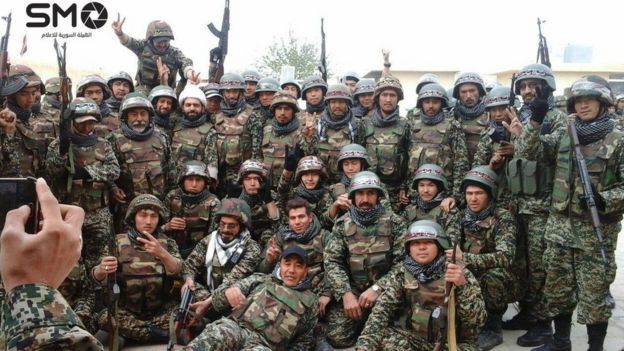WASHINGTON, April 25, 2016 — Up to 250 additional U.S. personnel are being deployed to Syria to support local forces on the ground and build on successes of U.S. forces already deployed there in the fight against the Islamic State of Iraq and the Levant, the Pentagon’s press secretary said today.
The additional personnel include special operations forces and medical and logistics personnel, Peter Cook told reporters at the Pentagon. The forces are to build on the gains of 50 previously deployed special operators in Syria, he said.
During a speech in Germany today, President Barack Obama announced the deployment of the additional forces. He said the expertise of the special operations forces already on the ground in Syria has been critical as local forces drive ISIL out of key areas.
Okay, so you now there is a major divide in the message, hence words matter, check out this exchange today between the media and the State Department spokesperson, John Kirby. Advance the video to the 25:00 minute mark and it ends about the 28:00 minute mark.
In 2015, when Obama deployed 50 special forces to Syria, the War Powers Act and authority began yet another huge debate in Congress.
Let us go back to 2015 shall we?
16 times Obama said there would be no boots on the ground in Syria
WASHINGTON — Since 2013, President Obama has repeatedly vowed that there would be no “boots on the ground” in Syria.
But White House press secretary Josh Earnest said the president’s decision Friday to send up to 50 special forces troops to Syria doesn’t change the fundamental strategy: “This is an important thing for the American people to understand. These forces do not have a combat mission.”
Earnest said the promises of “no boots on the ground” first came in the context of removing Syrian President Bashar Assad because of his use of chemical weapons. Since then, Syria has become a haven for Islamic State fighters.
Here’s a recap of Obama’s no-boots pledge:
Remarks before meeting with Baltic State leaders, Aug. 30, 2013
“In no event are we considering any kind of military action that would involve boots on the ground, that would involve a long-term campaign. But we are looking at the possibility of a limited, narrow act that would help make sure that not only Syria, but others around the world, understand that the international community cares about maintaining this chemical weapons ban and norm. So again, I repeat, we’re not considering any open-ended commitment. We’re not considering any boots-on-the-ground approach.”
Remarks in the Rose Garden, Aug. 31, 2013
“After careful deliberation, I have decided that the United States should take military action against Syrian regime targets. This would not be an open-ended intervention. We would not put boots on the ground. Instead, our action would be designed to be limited in duration and scope.”
Statement before meeting with congressional leaders, Sept. 3, 2013
“So the key point that I want to emphasize to the American people: The military plan that has been developed by our Joint Chiefs — and that I believe is appropriate — is proportional. It is limited. It does not involve boots on the ground. This is not Iraq, and this is not Afghanistan.”
News conference in Stockholm, Sweden, Sept. 4, 2013
“I think America recognizes that, as difficult as it is to take any military action — even one as limited as we’re talking about, even one without boots on the ground — that’s a sober decision.”
News conference in St. Petersburg, Russia, Sept. 6, 2013
“The question for the American people is, is that responsibility that we’ll be willing to bear? And I believe that when you have a limited, proportional strike like this — not Iraq, not putting boots on the ground; not some long, drawn-out affair; not without any risks, but with manageable risks — that we should be willing to bear that responsibility.”
Heck read the rest from USAToday.
In 2013, the White House sent a letter to the Congress on his power with regard to Syria, but it did not mention boots on the ground but rather strikes, meaning by manned and or unmanned aircraft.
Letter from the President — War Powers Resolution Regarding Syria
TEXT OF A LETTER FROM THE PRESIDENT
TO THE SPEAKER OF THE HOUSE OF REPRESENTATIVES
AND THE PRESIDENT PRO TEMPORE OF THE SENATESeptember 23, 2014
Dear Mr. Speaker: (Dear Mr. President:)
As I have repeatedly reported to the Congress, U.S. Armed Forces continue to conduct operations in a variety of locations against al-Qa’ida and associated forces. In furtherance of these U.S. counterterrorism efforts, on September 22, 2014, at my direction, U.S. military forces began a series of strikes in Syria against elements of al-Qa’ida known as the Khorasan Group. These strikes are necessary to defend the United States and our partners and allies against the threat posed by these elements.
I have directed these actions, which are in the national security and foreign policy interests of the United States, pursuant to my constitutional and statutory authority as Commander in Chief (including the authority to carry out Public Law 107-40) and as Chief Executive, as well as my constitutional and statutory authority to conduct the foreign relations of the United States. I am providing this report as part of my efforts to keep the Congress fully informed, consistent with the War Powers Resolution (Public Law 93-148). I appreciate the support of the Congress in this action.
Sincerely,
BARACK OBAMA

